GMC SIERRA 2007 Owner's Manual
Manufacturer: GMC, Model Year: 2007, Model line: SIERRA, Model: GMC SIERRA 2007Pages: 680, PDF Size: 3.42 MB
Page 231 of 680
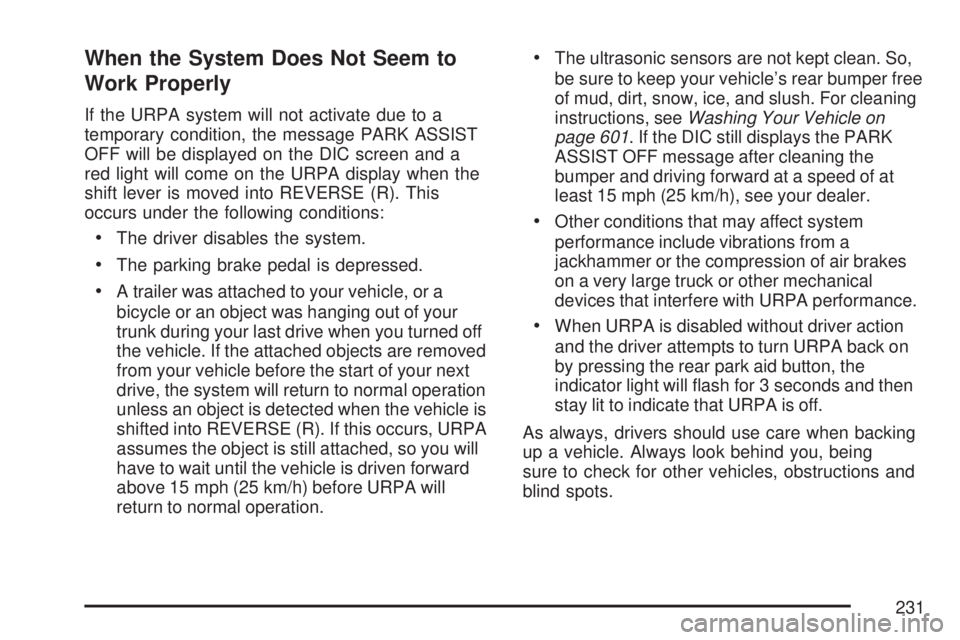
When the System Does Not Seem to
Work Properly
If the URPA system will not activate due to a
temporary condition, the message PARK ASSIST
OFF will be displayed on the DIC screen and a
red light will come on the URPA display when the
shift lever is moved into REVERSE (R). This
occurs under the following conditions:
The driver disables the system.
The parking brake pedal is depressed.
A trailer was attached to your vehicle, or a
bicycle or an object was hanging out of your
trunk during your last drive when you turned off
the vehicle. If the attached objects are removed
from your vehicle before the start of your next
drive, the system will return to normal operation
unless an object is detected when the vehicle is
shifted into REVERSE (R). If this occurs, URPA
assumes the object is still attached, so you will
have to wait until the vehicle is driven forward
above 15 mph (25 km/h) before URPA will
return to normal operation.
The ultrasonic sensors are not kept clean. So,
be sure to keep your vehicle’s rear bumper free
of mud, dirt, snow, ice, and slush. For cleaning
instructions, seeWashing Your Vehicle on
page 601. If the DIC still displays the PARK
ASSIST OFF message after cleaning the
bumper and driving forward at a speed of at
least 15 mph (25 km/h), see your dealer.
Other conditions that may affect system
performance include vibrations from a
jackhammer or the compression of air brakes
on a very large truck or other mechanical
devices that interfere with URPA performance.
When URPA is disabled without driver action
and the driver attempts to turn URPA back on
by pressing the rear park aid button, the
indicator light will �ash for 3 seconds and then
stay lit to indicate that URPA is off.
As always, drivers should use care when backing
up a vehicle. Always look behind you, being
sure to check for other vehicles, obstructions and
blind spots.
231
Page 232 of 680
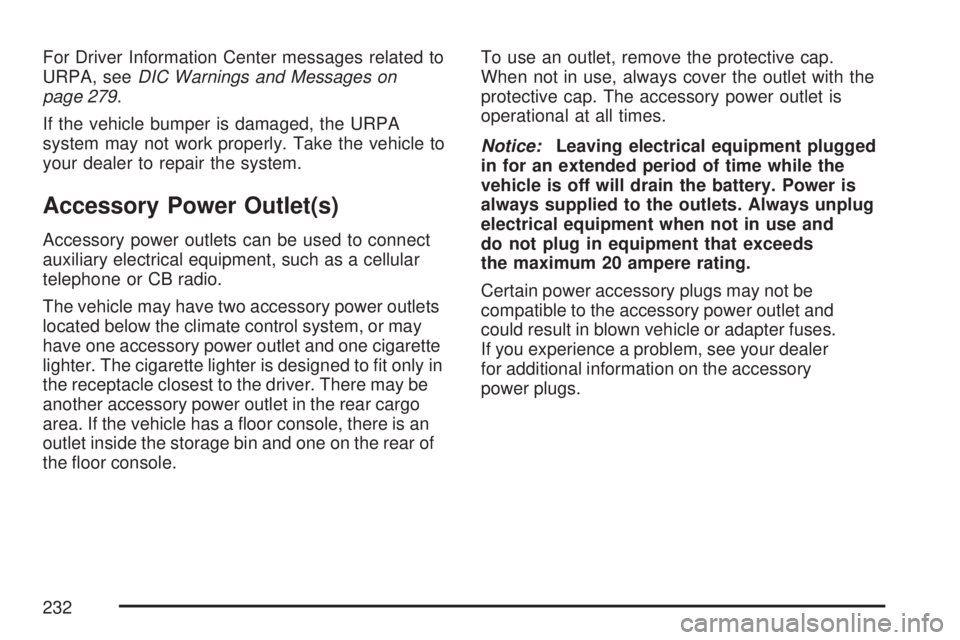
For Driver Information Center messages related to
URPA, seeDIC Warnings and Messages on
page 279.
If the vehicle bumper is damaged, the URPA
system may not work properly. Take the vehicle to
your dealer to repair the system.
Accessory Power Outlet(s)
Accessory power outlets can be used to connect
auxiliary electrical equipment, such as a cellular
telephone or CB radio.
The vehicle may have two accessory power outlets
located below the climate control system, or may
have one accessory power outlet and one cigarette
lighter. The cigarette lighter is designed to �t only in
the receptacle closest to the driver. There may be
another accessory power outlet in the rear cargo
area. If the vehicle has a �oor console, there is an
outlet inside the storage bin and one on the rear of
the �oor console.To use an outlet, remove the protective cap.
When not in use, always cover the outlet with the
protective cap. The accessory power outlet is
operational at all times.
Notice:Leaving electrical equipment plugged
in for an extended period of time while the
vehicle is off will drain the battery. Power is
always supplied to the outlets. Always unplug
electrical equipment when not in use and
do not plug in equipment that exceeds
the maximum 20 ampere rating.
Certain power accessory plugs may not be
compatible to the accessory power outlet and
could result in blown vehicle or adapter fuses.
If you experience a problem, see your dealer
for additional information on the accessory
power plugs.
232
Page 233 of 680
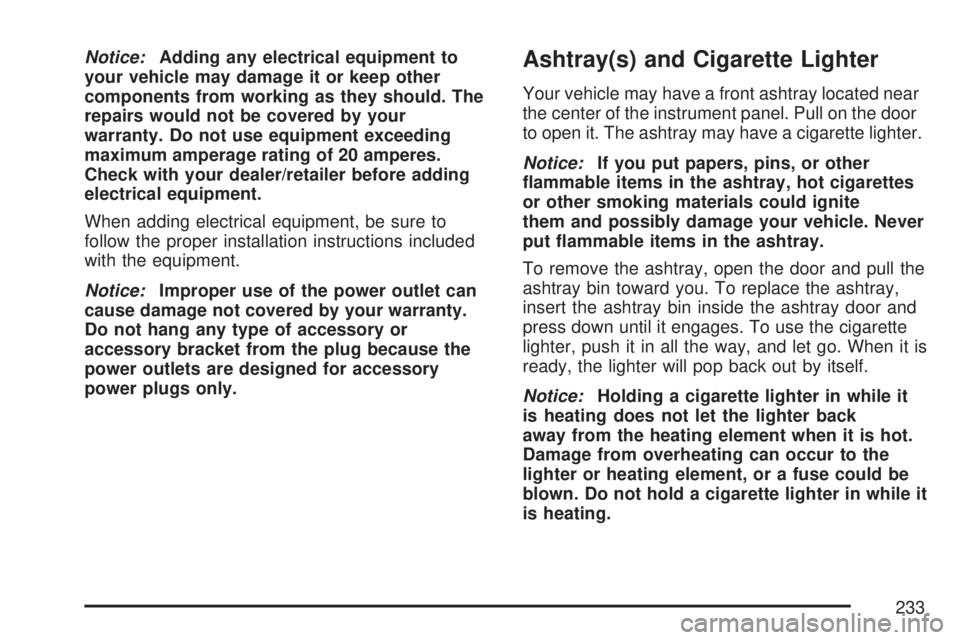
Notice:Adding any electrical equipment to
your vehicle may damage it or keep other
components from working as they should. The
repairs would not be covered by your
warranty. Do not use equipment exceeding
maximum amperage rating of 20 amperes.
Check with your dealer/retailer before adding
electrical equipment.
When adding electrical equipment, be sure to
follow the proper installation instructions included
with the equipment.
Notice:Improper use of the power outlet can
cause damage not covered by your warranty.
Do not hang any type of accessory or
accessory bracket from the plug because the
power outlets are designed for accessory
power plugs only.Ashtray(s) and Cigarette Lighter
Your vehicle may have a front ashtray located near
the center of the instrument panel. Pull on the door
to open it. The ashtray may have a cigarette lighter.
Notice:If you put papers, pins, or other
�ammable items in the ashtray, hot cigarettes
or other smoking materials could ignite
them and possibly damage your vehicle. Never
put �ammable items in the ashtray.
To remove the ashtray, open the door and pull the
ashtray bin toward you. To replace the ashtray,
insert the ashtray bin inside the ashtray door and
press down until it engages. To use the cigarette
lighter, push it in all the way, and let go. When it is
ready, the lighter will pop back out by itself.
Notice:Holding a cigarette lighter in while it
is heating does not let the lighter back
away from the heating element when it is hot.
Damage from overheating can occur to the
lighter or heating element, or a fuse could be
blown. Do not hold a cigarette lighter in while it
is heating.
233
Page 234 of 680
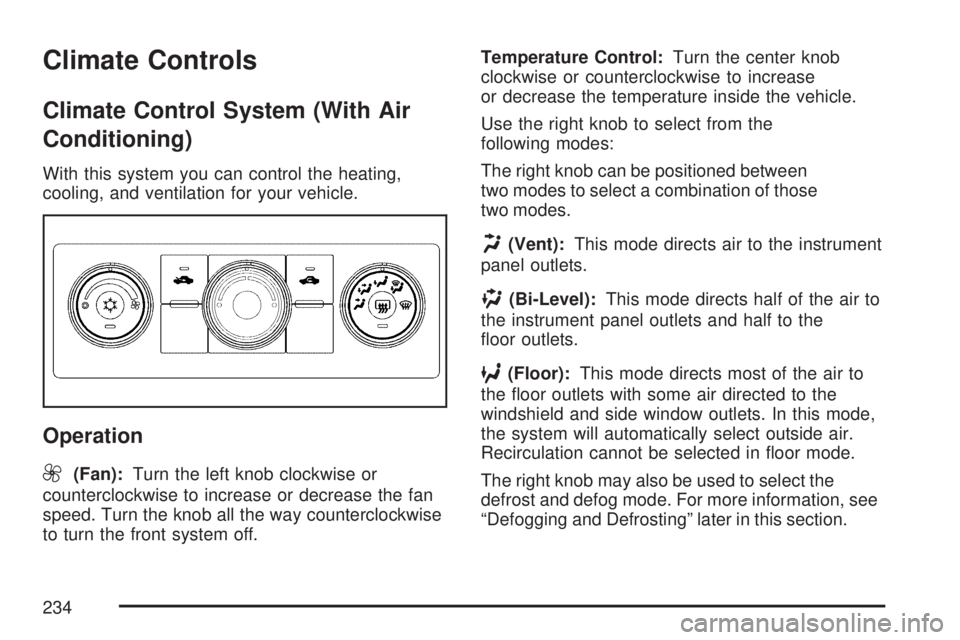
Climate Controls
Climate Control System (With Air
Conditioning)
With this system you can control the heating,
cooling, and ventilation for your vehicle.
Operation
9
(Fan):Turn the left knob clockwise or
counterclockwise to increase or decrease the fan
speed. Turn the knob all the way counterclockwise
to turn the front system off.Temperature Control:Turn the center knob
clockwise or counterclockwise to increase
or decrease the temperature inside the vehicle.
Use the right knob to select from the
following modes:
The right knob can be positioned between
two modes to select a combination of those
two modes.
H(Vent):This mode directs air to the instrument
panel outlets.
)(Bi-Level):This mode directs half of the air to
the instrument panel outlets and half to the
�oor outlets.
6(Floor):This mode directs most of the air to
the �oor outlets with some air directed to the
windshield and side window outlets. In this mode,
the system will automatically select outside air.
Recirculation cannot be selected in �oor mode.
The right knob may also be used to select the
defrost and defog mode. For more information, see
“Defogging and Defrosting” later in this section.
234
Page 235 of 680
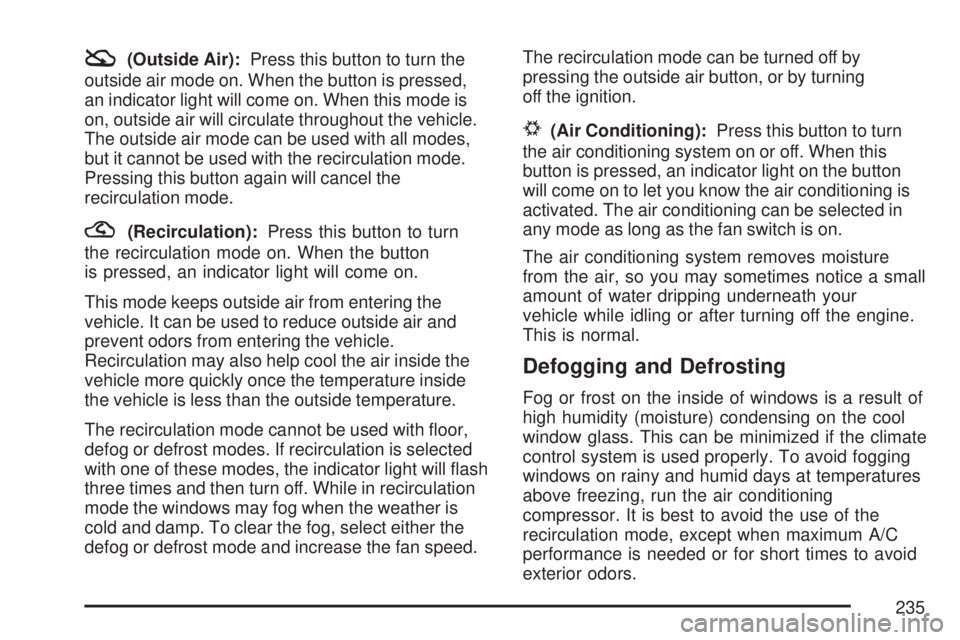
:(Outside Air):Press this button to turn the
outside air mode on. When the button is pressed,
an indicator light will come on. When this mode is
on, outside air will circulate throughout the vehicle.
The outside air mode can be used with all modes,
but it cannot be used with the recirculation mode.
Pressing this button again will cancel the
recirculation mode.
?(Recirculation):Press this button to turn
the recirculation mode on. When the button
is pressed, an indicator light will come on.
This mode keeps outside air from entering the
vehicle. It can be used to reduce outside air and
prevent odors from entering the vehicle.
Recirculation may also help cool the air inside the
vehicle more quickly once the temperature inside
the vehicle is less than the outside temperature.
The recirculation mode cannot be used with �oor,
defog or defrost modes. If recirculation is selected
with one of these modes, the indicator light will �ash
three times and then turn off. While in recirculation
mode the windows may fog when the weather is
cold and damp. To clear the fog, select either the
defog or defrost mode and increase the fan speed.The recirculation mode can be turned off by
pressing the outside air button, or by turning
off the ignition.
#(Air Conditioning):Press this button to turn
the air conditioning system on or off. When this
button is pressed, an indicator light on the button
will come on to let you know the air conditioning is
activated. The air conditioning can be selected in
any mode as long as the fan switch is on.
The air conditioning system removes moisture
from the air, so you may sometimes notice a small
amount of water dripping underneath your
vehicle while idling or after turning off the engine.
This is normal.
Defogging and Defrosting
Fog or frost on the inside of windows is a result of
high humidity (moisture) condensing on the cool
window glass. This can be minimized if the climate
control system is used properly. To avoid fogging
windows on rainy and humid days at temperatures
above freezing, run the air conditioning
compressor. It is best to avoid the use of the
recirculation mode, except when maximum A/C
performance is needed or for short times to avoid
exterior odors.
235
Page 236 of 680
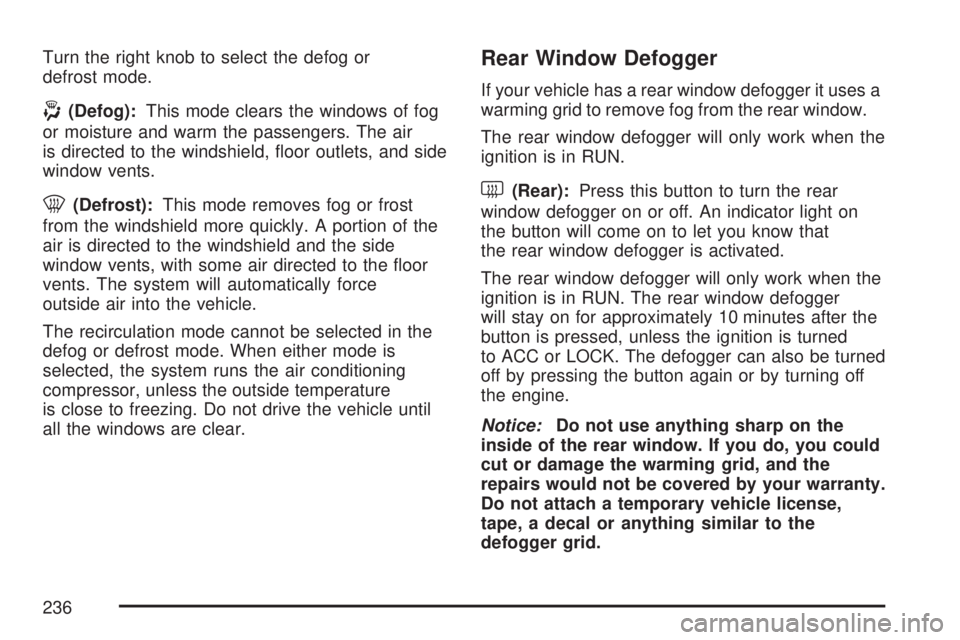
Turn the right knob to select the defog or
defrost mode.
-(Defog):This mode clears the windows of fog
or moisture and warm the passengers. The air
is directed to the windshield, �oor outlets, and side
window vents.
0(Defrost):This mode removes fog or frost
from the windshield more quickly. A portion of the
air is directed to the windshield and the side
window vents, with some air directed to the �oor
vents. The system will automatically force
outside air into the vehicle.
The recirculation mode cannot be selected in the
defog or defrost mode. When either mode is
selected, the system runs the air conditioning
compressor, unless the outside temperature
is close to freezing. Do not drive the vehicle until
all the windows are clear.
Rear Window Defogger
If your vehicle has a rear window defogger it uses a
warming grid to remove fog from the rear window.
The rear window defogger will only work when the
ignition is in RUN.
<(Rear):Press this button to turn the rear
window defogger on or off. An indicator light on
the button will come on to let you know that
the rear window defogger is activated.
The rear window defogger will only work when the
ignition is in RUN. The rear window defogger
will stay on for approximately 10 minutes after the
button is pressed, unless the ignition is turned
to ACC or LOCK. The defogger can also be turned
off by pressing the button again or by turning off
the engine.
Notice:Do not use anything sharp on the
inside of the rear window. If you do, you could
cut or damage the warming grid, and the
repairs would not be covered by your warranty.
Do not attach a temporary vehicle license,
tape, a decal or anything similar to the
defogger grid.
236
Page 237 of 680
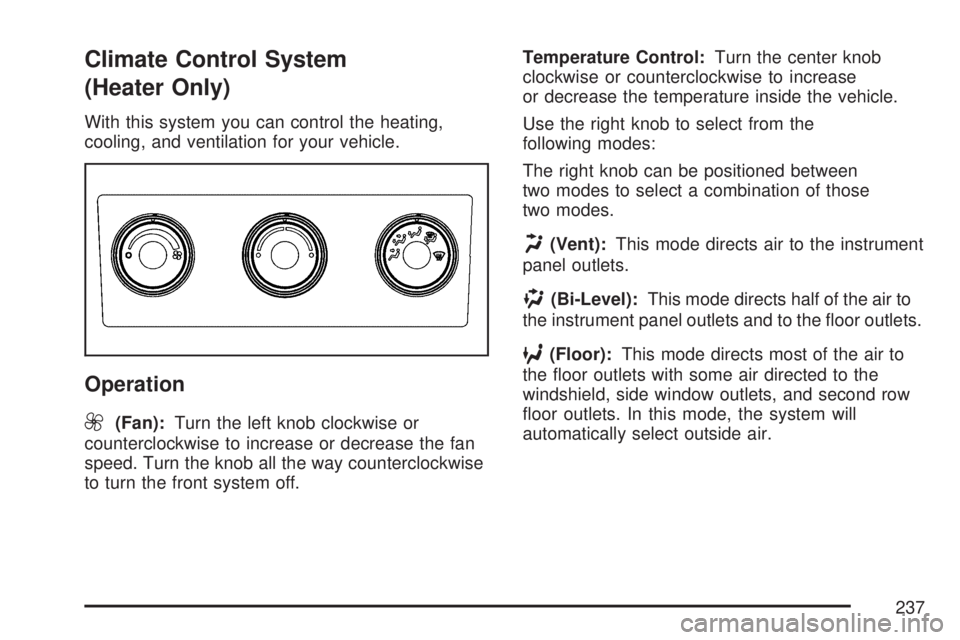
Climate Control System
(Heater Only)
With this system you can control the heating,
cooling, and ventilation for your vehicle.
Operation
9
(Fan):Turn the left knob clockwise or
counterclockwise to increase or decrease the fan
speed. Turn the knob all the way counterclockwise
to turn the front system off.Temperature Control:Turn the center knob
clockwise or counterclockwise to increase
or decrease the temperature inside the vehicle.
Use the right knob to select from the
following modes:
The right knob can be positioned between
two modes to select a combination of those
two modes.
H(Vent):This mode directs air to the instrument
panel outlets.
)(Bi-Level):This mode directs half of the air to
the instrument panel outlets and to the �oor outlets.
6(Floor):This mode directs most of the air to
the �oor outlets with some air directed to the
windshield, side window outlets, and second row
�oor outlets. In this mode, the system will
automatically select outside air.
237
Page 238 of 680
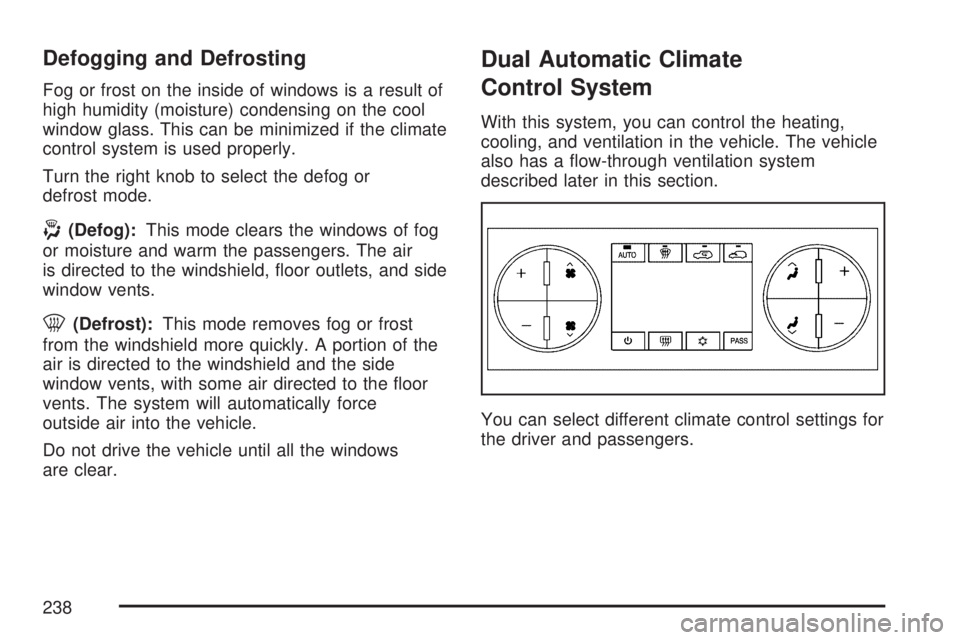
Defogging and Defrosting
Fog or frost on the inside of windows is a result of
high humidity (moisture) condensing on the cool
window glass. This can be minimized if the climate
control system is used properly.
Turn the right knob to select the defog or
defrost mode.
-(Defog):This mode clears the windows of fog
or moisture and warm the passengers. The air
is directed to the windshield, �oor outlets, and side
window vents.
0(Defrost):This mode removes fog or frost
from the windshield more quickly. A portion of the
air is directed to the windshield and the side
window vents, with some air directed to the �oor
vents. The system will automatically force
outside air into the vehicle.
Do not drive the vehicle until all the windows
are clear.
Dual Automatic Climate
Control System
With this system, you can control the heating,
cooling, and ventilation in the vehicle. The vehicle
also has a �ow-through ventilation system
described later in this section.
You can select different climate control settings for
the driver and passengers.
238
Page 239 of 680
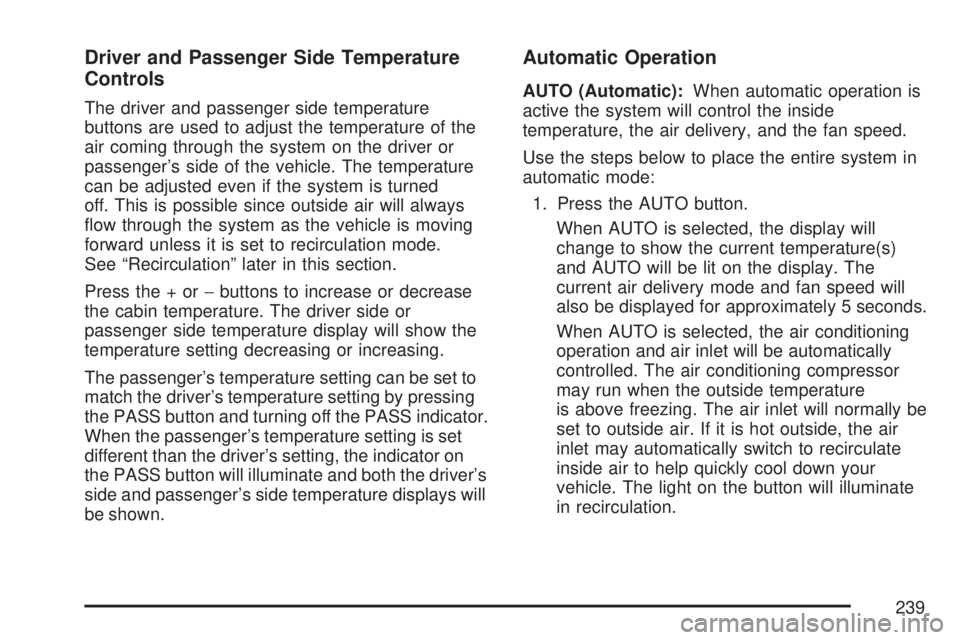
Driver and Passenger Side Temperature
Controls
The driver and passenger side temperature
buttons are used to adjust the temperature of the
air coming through the system on the driver or
passenger’s side of the vehicle. The temperature
can be adjusted even if the system is turned
off. This is possible since outside air will always
�ow through the system as the vehicle is moving
forward unless it is set to recirculation mode.
See “Recirculation” later in this section.
Press the + or−buttons to increase or decrease
the cabin temperature. The driver side or
passenger side temperature display will show the
temperature setting decreasing or increasing.
The passenger’s temperature setting can be set to
match the driver’s temperature setting by pressing
the PASS button and turning off the PASS indicator.
When the passenger’s temperature setting is set
different than the driver’s setting, the indicator on
the PASS button will illuminate and both the driver’s
side and passenger’s side temperature displays will
be shown.
Automatic Operation
AUTO (Automatic):When automatic operation is
active the system will control the inside
temperature, the air delivery, and the fan speed.
Use the steps below to place the entire system in
automatic mode:
1. Press the AUTO button.
When AUTO is selected, the display will
change to show the current temperature(s)
and AUTO will be lit on the display. The
current air delivery mode and fan speed will
also be displayed for approximately 5 seconds.
When AUTO is selected, the air conditioning
operation and air inlet will be automatically
controlled. The air conditioning compressor
may run when the outside temperature
is above freezing. The air inlet will normally be
set to outside air. If it is hot outside, the air
inlet may automatically switch to recirculate
inside air to help quickly cool down your
vehicle. The light on the button will illuminate
in recirculation.
239
Page 240 of 680
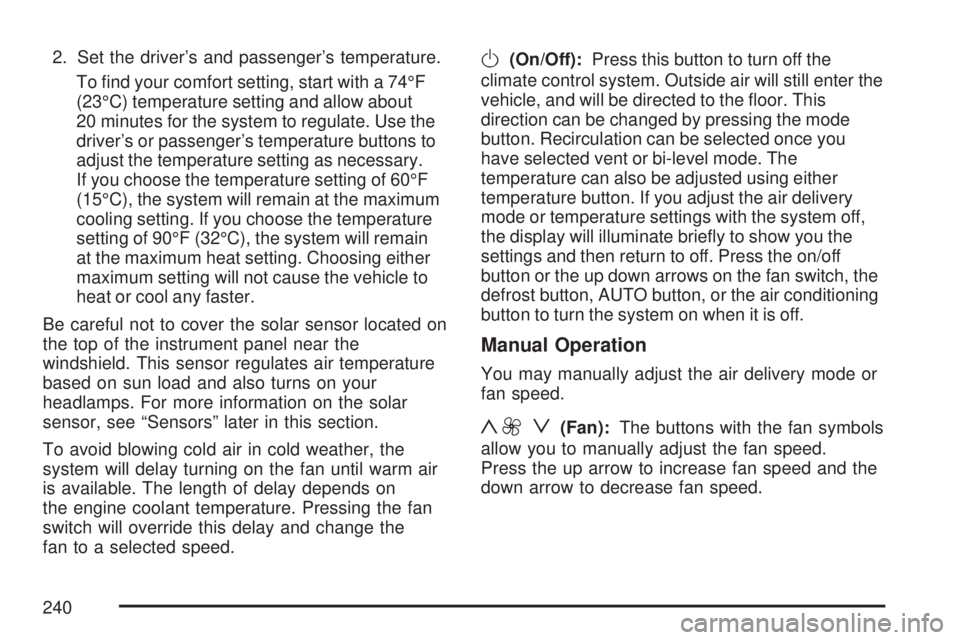
2. Set the driver’s and passenger’s temperature.
To �nd your comfort setting, start with a 74°F
(23°C) temperature setting and allow about
20 minutes for the system to regulate. Use the
driver’s or passenger’s temperature buttons to
adjust the temperature setting as necessary.
If you choose the temperature setting of 60°F
(15°C), the system will remain at the maximum
cooling setting. If you choose the temperature
setting of 90°F (32°C), the system will remain
at the maximum heat setting. Choosing either
maximum setting will not cause the vehicle to
heat or cool any faster.
Be careful not to cover the solar sensor located on
the top of the instrument panel near the
windshield. This sensor regulates air temperature
based on sun load and also turns on your
headlamps. For more information on the solar
sensor, see “Sensors” later in this section.
To avoid blowing cold air in cold weather, the
system will delay turning on the fan until warm air
is available. The length of delay depends on
the engine coolant temperature. Pressing the fan
switch will override this delay and change the
fan to a selected speed.O(On/Off):Press this button to turn off the
climate control system. Outside air will still enter the
vehicle, and will be directed to the �oor. This
direction can be changed by pressing the mode
button. Recirculation can be selected once you
have selected vent or bi-level mode. The
temperature can also be adjusted using either
temperature button. If you adjust the air delivery
mode or temperature settings with the system off,
the display will illuminate brie�y to show you the
settings and then return to off. Press the on/off
button or the up down arrows on the fan switch, the
defrost button, AUTO button, or the air conditioning
button to turn the system on when it is off.
Manual Operation
You may manually adjust the air delivery mode or
fan speed.
y9 z(Fan):The buttons with the fan symbols
allow you to manually adjust the fan speed.
Press the up arrow to increase fan speed and the
down arrow to decrease fan speed.
240